8.4 /10 1 Votes
8.5/10 TV Country of origin United Kingdom No. of series 10 First episode date 23 September 1988 Presented by Clive Anderson | 8.3/10 IMDb Genre Improvisational comedy Original language(s) English No. of episodes 136 (list of episodes) Final episode date 4 February 1999 Network Channel 4 | |||||||||||||||||||||||||||||||||
 | ||||||||||||||||||||||||||||||||||
Created by Dan Patterson
Mark Leveson Locations Limehouse Studios (1988), Teddington Studios (1989–1991), The London Studios (1992–1998) Cast Colin Mochrie, Ryan Stiles, Greg Proops, Wayne Brady, Drew Carey Similar Trust Us with Your Life, Drew Carey's Green Sc, Mock the Week, Drew Carey's Improv‑A‑Ganza, Fast and Loose Profiles | ||||||||||||||||||||||||||||||||||
Whose Line is it Anyway? (abbreviated to Whose Line? or WLIIA) is a short-form improvisational comedy television show. Originally a British radio programme, it moved to television in 1988 as a series made for Channel 4.
Contents

The show consists of a panel of four performers who create characters, scenes and songs on the spot, in the style of short-form improvisation games, many taken from theatresports. Topics for the games are based on either audience suggestions or predetermined prompts from the host. Both the British and the American shows ostensibly take the form of a game show with the host arbitrarily assigning points and likewise choosing a winner at the end of each episode. However, the show lacks the true stakes and competition of a game show (by design). The "game show" format is simply part of the comedy.
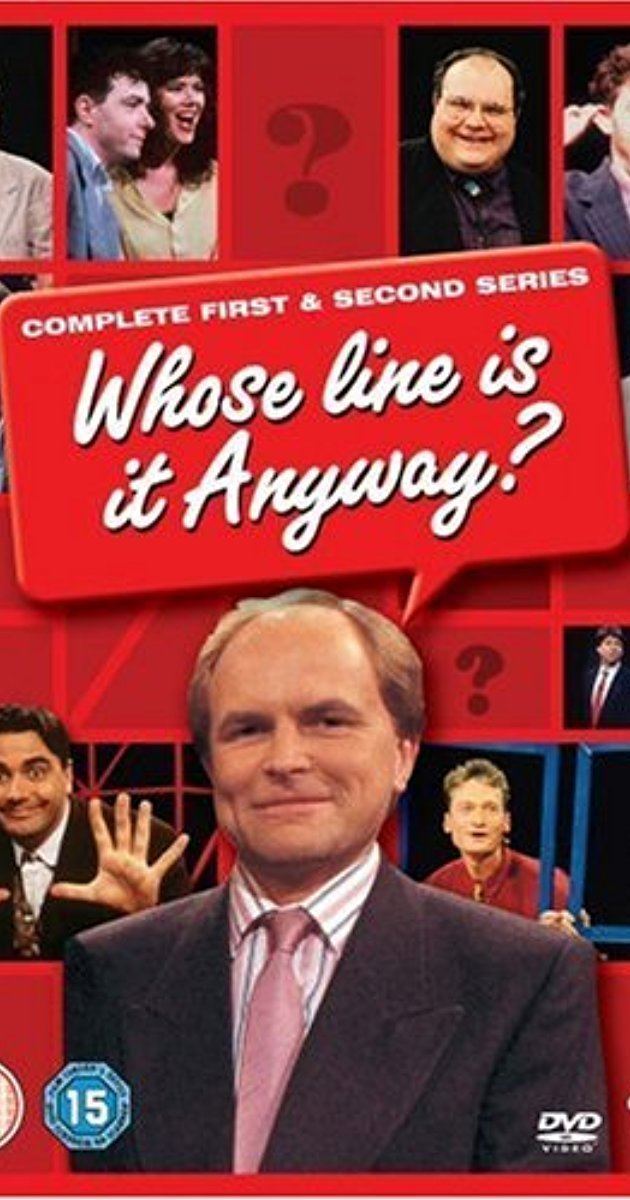
Following the conclusion of the British run in 1999, ABC began airing an American version, which ran until 2007 and was later revived by The CW in 2013.
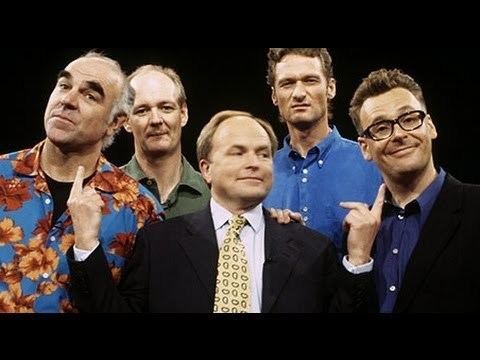
In 2016, The Comedy Channel will begin airing an Australian Version of the series with comedian Tommy Little as host.
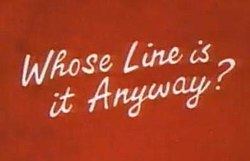
Format
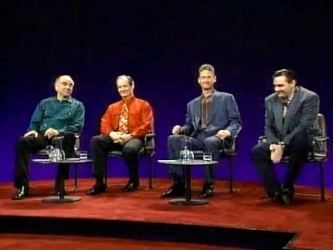
Each typical television episode of Whose Line Is It Anyway? featured four performers (with an exception of six in a 1989 Christmas special) who sit in a line of chairs at the back of the stage. The host sat at a desk facing the large performance area in front of the performers. The host introduced each performer with a joke or pun, usually all related on a common theme or topic.
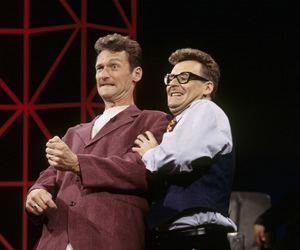
The show is made up of games that are scored by the host, who declared arbitrary point values after the game, often citing a humorous reason for his decision. The points are purely decorative, served no practical purpose, and were often awarded to audience members or other arbitrary third persons. The style of the games are varied (see Games, below). Some feature all four performers, while others feature fewer. The performers who are not involved in a game remain in their seats at the back of the stage. Humorous banter between the host and the performers between games is also sometimes featured.

At the conclusion of each episode, a winner or several winners are chosen arbitrarily by the host. The "prize" for winning on the British version of the show is to read the credits in a certain style, chosen by the host, as they scrolled. On the American series, the "prize" is either to play a game with the host, or to sit out while the other performers did. After this game, credits simply roll under the show's theme. In season two, the credit-reading, usually including all of the performers, was adopted from the UK series following the "prize" game.
Episodes were culled down from longer recording sessions with the best game performances chosen to compile into one or more episodes. The UK series each include one or two compilation shows of unaired games from different taping sessions in that series.
Games
The number and type of games played vary from episode to episode, and whilst some games such as "Questions Only" and "Hoedown" became more common over time, others such as "Authors" and "Remote Control" faded from use. New games were created throughout the show's run. Some games, such as "Tag", are based on traditional improv games, while others are uniquely created for the series.
While all games are designed to test the performer's improvisational skill, some also test other skills, such as singing or doing impressions. Whose Line? features a number of musical games, which feature one or more of the show's resident musicians playing live backing music. Occasionally, pre-recorded music is also used. While they were good sports about it, many of the performers despised the musical games. In one episode, Stephen Fry is asked to perform a rap, and starts to do so halfheartedly, but gives up after a few words, and Ryan Stiles would frequently inject insults into the Hoedown whenever he is forced to sing it, usually pointed at the host or the Hoedown itself. Colin Mochrie would generally speak his lines instead of singing them for musical games.
Some games require suggestions or topics. The host sometimes calls to the studio audience for suggestions that a game requires, while for other games this information is written by the production staff, or is submitted by the audience in advance, and chosen from those submissions. The host also controls a buzzer, which ends most games (or individual sections of rapid-fire games).
Opening sequence
The show has a visual opening sequence that changed over the series. In the first series, the title sequence shows clips from the actual show under the main theme. The sequence introduced in the second series features shots of actors in various styles of dress and activity whose exposed skin had been blackened out as though the actors are performing blackface as a special effect, and in between scenes, there is a shot of Clive's hand pressing his buzzer. The final sequence features a white line on a red screen, out of which a series of four characters, drawn simply as white outlines, appear and interact. The style is similar to that of La Linea by Osvaldo Cavandoli. The same line figures are superimposed above a picture of Los Angeles' famous Hollywood Sign for the last series. The British version's theme song was written by Philip Pope.
History
Whose Line Is It Anyway? was created by Dan Patterson and Mark Leveson in 1988 as a radio show on BBC Radio 4. This early incarnation of the show is notable as being the origin of the show's tradition of having the performers read the credits in an amusing style; as it was a radio show, it was necessary for somebody to read the credits, and it was decided that it might as well be done as part of the programme proper, rather than being done by a traditional BBC Radio announcer. This approach to reading credits was pioneered by the earlier BBC radio show I'm Sorry, I'll Read That Again. The title of the show itself is a comedic riposte to another radio show that moved to television, What's My Line, merged with the title of a 1972 teleplay (and eventual theatrical play) Whose Life Is It Anyway?. The radio series consisted of six episodes, with Clive Anderson as host, with John Sessions and Stephen Fry as regulars.
Originally, the producers asked the BBC to move to television; however the BBC was hesitant about this move. By this time, an already eager Channel 4 bought the show. Believing the show would become a hit, Channel 4 ordered 13 episodes for the first series, uncommon in the UK where a TV series often consists of just six episodes in its first year. However, this came as a problem between two cast members. Original plans were to have Sessions and Fry as regulars with the rotation of two performers, but Stephen Fry pulled out as he was often scared performing it on radio, however, Sessions, with some persuasion from Fry, continued his role on the show. With the exception of Sessions in the first series and Ryan Stiles and Colin Mochrie starting with the seventh and eighth series (respectively), there were no fixed regulars on the show, though there were many recurring regulars (including four appearances by Fry).
The British television version lasted for a total of 10 series, with 136 episodes, all of which were hosted by Clive Anderson. The UK show was canceled when the ratings began to slump, but found immediate new life in America when its version aired. One of the early North American broadcasters of the British series was the Canadian youth channel YTV, though many episodes were edited for adult language and content.
Most episodes of the British television programme were primarily shot in London. However, half of the episodes for each of series three and four were taped in New York, and series 10 was filmed entirely in Hollywood in the same studio that would host the American version, Raleigh Studios. This final series was first broadcast only in the U.S. on the Comedy Central cable channel. These episodes shot in the United States were often criticized by both fans and critics as being of a lower quality to the London shot episodes. Reruns of the entire British TV series had been running on Comedy Central since the early 1990s, though some episodes were edited to remove games, rearrange games in a show, or remove content that American audiences may find offensive. Repeats of the British series moved to BBC America in April 2006; however, the network has not shown any episodes taped before 1994.
In the late 1990s, the show was brought to the attention of Drew Carey, who worked with regular Whose Line? performer Ryan Stiles, a co-star on the U.S. TV sitcom The Drew Carey Show. Carey convinced ABC to air test episodes in the United States. The U.S. version of the series became an inexpensive hit (though less so than the British version had been in the UK). ABC kept Carey on as host, and featured Mochrie and Stiles as permanent performers. Wayne Brady, who had also appeared in several UK episodes, was also made a permanent US cast member after the first few episodes, meaning there was only one guest performer per show. Several other performers from the U.K. series also appeared on the U.S. series. The show ran on ABC for eight seasons. In 2013, the CW network revived the U.S. version with Aisha Tyler as host and regulars Stiles, Brady and Mochrie returning.
On 6 March 2011, a special edition of the show was recorded for "24 Hour Panel People", a marathon of UK panel shows, in aid of Comic Relief. The recording was broadcast live on the Comic Relief website at about 9:30am, and, the edited compilation shows for the event, shown 13–17 March on BBC Three. The performers were Humphrey Ker, Josie Lawrence, Neil Mullarkey, Tony Slattery and David Walliams.
Performers
The original BBC Radio 4 broadcasts consists of host Clive Anderson along with two guests and the two regular contestants, Stephen Fry and John Sessions. Clive Anderson stayed on as host when the show moved to television, with John Sessions resuming his role as the only regular in the first series. He subsequently became a rotating regular in the second and third series. However he appears only twice in the third series, these being his final appearances. Stephen Fry appears only occasionally on the television series.
Ryan Stiles and Colin Mochrie first appear in the second and third series respectively; they each gradually increase the frequency of their appearances to the point that both appear in every episode from the eighth series on. Stiles is the most prolific performer on the show, having appeared in 76 of the series' 136 episodes (including compilations). Wayne Brady, who became a regular on the US version, appears in the final UK series for five episodes, including compilations.
Many of the show's performers, including Paul Merton, Josie Lawrence and Sandi Toksvig, were regulars with The Comedy Store Players, an improvisational group based at London's Comedy Store. Other regular performers from the British version include a variety of British, American, and Canadian comedians such as Greg Proops, Tony Slattery, Mike McShane, Stephen Frost, Brad Sherwood, Chip Esten and Jim Sweeney. The series also occasionally features celebrities in the fourth chair, such as Peter Cook, George Wendt, and Jonathan Pryce.
On the original BBC Radio series, the music was provided by Colin Sell, but when the show migrated to television, Richard Vranch (also of The Comedy Store Players) became the resident musician until the last series of the British show, playing electric guitar and piano and other instruments. For the tenth series in Hollywood, Laura Hall took over, playing mainly keyboards, and went on to be the in-house musician for the American series.
DVD release
The first release of the U.K. show, featuring the first two series, was released on DVD in America on 27 March 2007 and in the UK on 25 January 2008. The U.K. edition is edited to remove references to the ad breaks. Also, British episodes were released on VHS (in the UK only) in the mid-1990s. Additionally, a play-at-home book was printed in 1989, related to the British series.
Almost all of the UK versions (135 of 136 episodes) of Whose Line Is It Anyway? are available for free to those living in the UK on All 4.
